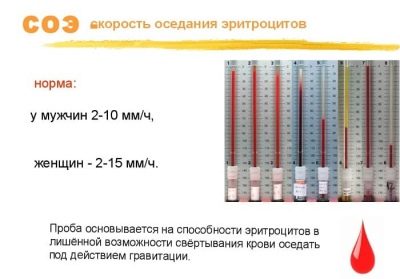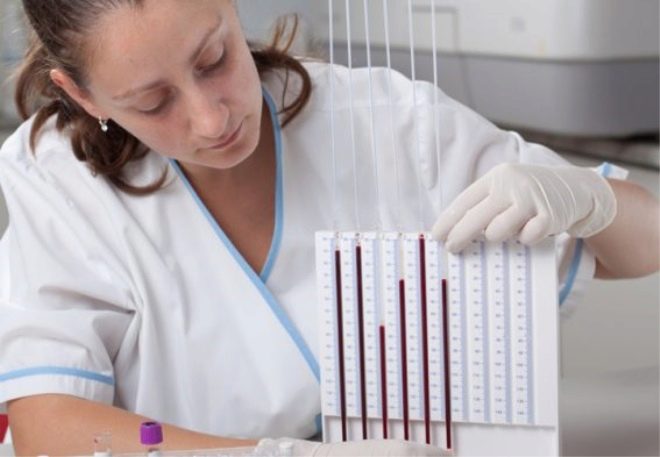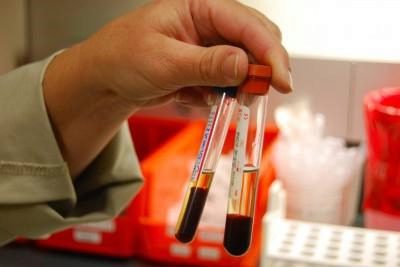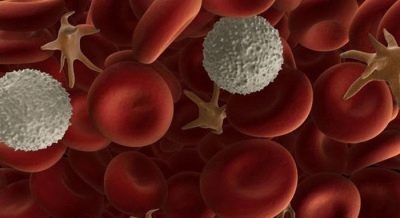Why determine the ESR during pregnancy and what is its norm?
The blood tests that the future mom should give up often are very important. They allow doctors to control both the condition of the woman and her baby. One of the important indicators, which is determined during pregnancy, is ESR.
About ESR
During the carrying of the baby in the female body, many biological reactions change. This is largely due to the abundance of various hormones that are produced only in the period of pregnancy. They have a strong effect on the blood, which leads to a change in performance.
Red blood cells or red blood cells are essential. They are necessary for the transfer of various organic substances and oxygen to all cells of the body. In the period of childbearing the need for such substances increases significantly. This determines the importance of determining the ESR.
Erythrocyte sedimentation rate or ESR is a very important clinical indicator. His change, as a rule, is a marker for doctors that a woman has any violations.
In order to identify this indicator, laboratory technicians add a special anticoagulant to the blood serum. This is necessary so that the red blood cells do not stick together. Also, under the action of this chemical, the red blood cells gradually begin to settle.
During this process, the sedimentation rate is determined. To assess the indicator, scientists have identified a certain period of time. As a result of the analysis, the value obtained within one hour is taken out. This criterion is international and is used in different countries of the world. This allows doctors from different states to understand each other.
Erythrocyte sedimentation rate in blood is determined. It is impossible to determine this indicator in urine or other biological fluids.
To determine the erythrocyte sedimentation rate, a special technique is used. A convenient version of its application was offered to the world’s medical community by two scientists in 1926 and 1935, respectively.
The method of determining this indicator is currently used. on Westergren. It is quite simple and convenient, which allows it to be used in medical practice almost everywhere.
Why is it determined in pregnant women?
The importance of this analysis in pregnant women cannot be overemphasized. Using this simple and routine laboratory test, you can determine the presence of any pathology in both the mother and the baby.
ESR is a characteristic marker showing the severity of functional impairment. The more he is elevated, the more dangerous any pathology for the female body.
Given the importance of this laboratory test, doctors recommend expectant mothers to donate blood for the determination of ESR during pregnancy at least three times. Such studies are usually conducted at 12, 21, and 30 weeks of gestation of babies.
If necessary, they can be appointed more often. This is decided by the attending physician, who oversees the course of pregnancy in a particular patient.
Norms
Doctors believe that after conception of a baby in a pregnant woman, this clinical indicator gradually changes by the weeks of her pregnancy. However, it happens rather slowly.
The normal values of this indicator are somewhat different in pregnant and non-pregnant women.
So, before pregnancy, the ESR rate should be less than 15 mm / hour.
In the future, the values of this indicator will vary somewhat. For convenience, doctors use a special table in which the normal values of this indicator were entered. It is presented below:
Gestation period | ESR value (in mm / hour) |
In 1 trimester | 11-21 |
2 trimester | 22-30 |
In 3 trimester | Up to 50 |
With the help of this tablet it is quite simple to determine whether any violations are present in the future mom's body. If in the first trimester of pregnancy ESR reaches 45 mm and higher. Hg This situation, as a rule, is already pathological. In the third trimester, it is a variant of the norm.
Already by the second period of pregnancy, the ESR indicators begin to increase. This is largely due to the changing concentration of fibrinogen in the female body. This substance begins to increase, which contributes to increased ESR.
The maximum concentration of fibrinogen in expectant mothers is recorded by the end of the third trimester of pregnancy. Such changes are reflected in blood clotting. Quite often, these figures change together. Typically, such changes are well identified through various laboratory tests.
It is important to note that the above figures are averaged. Some women have an ESR before pregnancy. In some cases, this is an individual feature.
In such a situation, it is very important to show your doctor the results of previous tests. This will help the doctor not to make a mistake and make the correct diagnosis.
How is the analysis done?
The determination of ESR during pregnancy is a routine and routine procedure. You can take this analysis at any antenatal clinic. For this, the doctor will give the future mother a special medical form - referral. With this document, she should visit the clinic.
Hand over the analysis should be on an empty stomach. The procedure for blood sampling is no different from that when conducting a general blood test. For convenience, doctors many years ago decided to include ESR in the results of this study.
Blood sampling can be done in two ways:
- The first one is a puncture of a finger with a special device. In this case, the laboratory assistant takes capillary blood for research.
- The second method is intravenous puncture. In this case, venous blood is sent for examination. Currently, the advantage is mainly in the second way. He is less traumatic and better tolerated by future moms.
To pass such an analysis can be in a private laboratory. For this direction from the doctor is not necessary. The woman in this case handles the analysis independently. The term for obtaining the results is a few hours.
In the usual female consultation, he may be somewhat longer. It depends on the loading lab. In this case, the deadline for obtaining the result is, as a rule, 1-3 days.
The test procedure is extremely simple. To do this, the laboratory places the right amount of blood in a special tube. An anticoagulant is also infused there. This composition is aged for an hour. During this time period, blood is stratified into two components: shaped elements and its liquid part (plasma).
After that, the laboratory assistant evaluates the thickness of the layer formed by shaped elements, and also records the resulting indicator of the erythrocyte sedimentation rate.
Currently All studies are automatic. For this purpose, special laboratory analyzers are used. Such devices analyze fully autonomously, the “human factor” is almost completely excluded.
How is it decrypted and what are the causes of deviations?
Increased value
A variety of causal factors can lead to an increase in the erythrocyte sedimentation rate. Quite often, additional diagnostics are required to establish the cause of such disorders in the female body. This is done by a therapist who observes a pregnant woman. If necessary, the doctor can refer the future mom for consultation to the “narrow” specialists.
Anemia is one of the reasons that can lead to an increase in this indicator. For the formation of new red blood cells requires quite a lot of nutrients. This causes the basic properties of the blood to change. The consequence of such changes is the acceleration of ESR.
The decrease in the female diet of protein and all essential amino acids also leads to the development of these deviations. Usually such changes are found in women who are on a vegetarian diet during pregnancy. The lack of protein intake contributes to changes in the blood, which is manifested by an increase in ESR.
Exacerbation of various diseases is also a common cause of increasing erythrocyte sedimentation rate. The most banal situation is a viral infection or even a cold. The diseased organism responds with an increase in ESR. Many bacterial infections also lead to similar disorders. In order to ESR normalized, it takes a lot of time.
Systemic rheumatologic or oncologic pathologies may cause an increase in the erythrocyte sedimentation rate of the future mom. In this case, as a rule, this indicator rises substantially and stably remains elevated over a long period of time.
Quite a common pathology leading to increased ESR in expectant mothers, is the usual caries. Untreated teeth in time are a constant source of various types of infections. Correction of violations in this case requires a mandatory visit to the dentist.
Chronic pathology of the upper respiratory tract can also lead to accelerated ESR.
Diseases associated with impaired blood clotting often cause accelerated ESR. Varicose veins, thrombophlebitis and even hemorrhoids quite often cause an increase in the erythrocyte sedimentation rate. It is possible to reveal these pathologies with the help of a clinical examination, as well as using various tests for hemostasis.
It is important to note that high ESR can be an extremely dangerous sign for the fetus. An increase in this indicator above normal values is an indication for more advanced diagnostics. The most dangerous this condition in the late weeks of pregnancy. In this case, a mandatory medical correction of the resulting violations is required.
Low value
Much less often, but the ESR may be reduced. Very rarely, this is a physiological individual feature of the organism. More often, this situation develops as a manifestation of various pathologies of internal organs.
A rather dangerous disease can lead to a decrease in the erythrocyte sedimentation rate - erythremia. It is accompanied by disorders in the functioning of red blood cells.
The more pronounced this pathology, the more low ESR in the expectant mother.
Hypoglobulinemia is another pathological condition that leads to the development of similar disorders. In this case, the level of globulins is significantly reduced in peripheral blood. In such a situation, the future mother not only decreases the ESR noticeably, but also weakens the immune system.
Diseases of the muscular system can also lead to a persistent decrease in the erythrocyte sedimentation rate in the female body. One of these pathologies is myodystrophy. This disease is accompanied by severe weakness in many muscle groups.Without treatment, the development of adverse symptoms develops rapidly.
Sickle cell anemia is a pathology that is accompanied by persistent changes in the structure and functioning of red blood cells. At certain stages of the development of this disease there is a significant decrease in ESR.
Without treatment, the prognosis of this pathology is unfavorable.
For more information on why ESR is determined during pregnancy and what is its norm, see the following video.


























